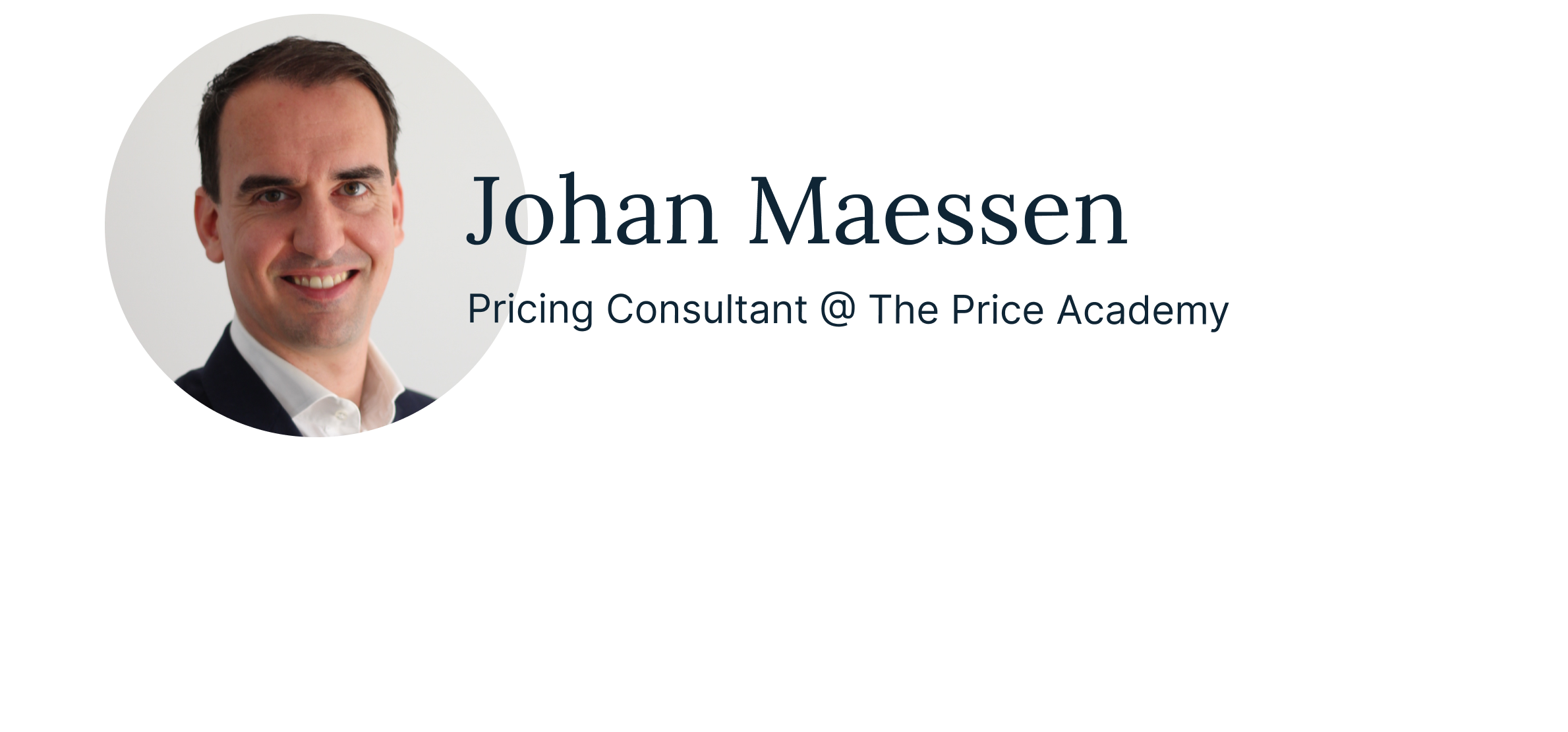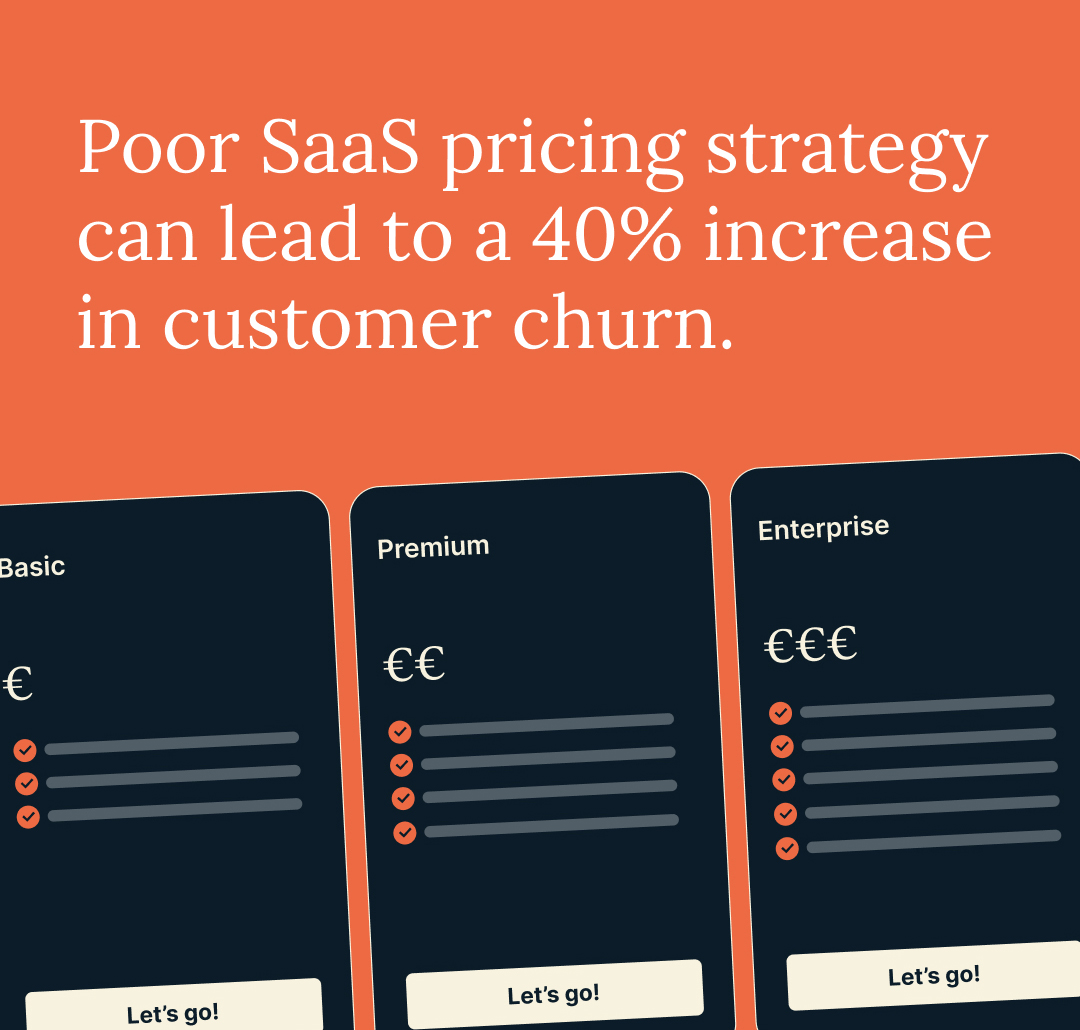Optimising your pricing strategy – An interview with Johan Maessen, SaaS pricing expert.
“Companies without a defined pricing strategy generate 10% less revenue per user than those with well-structured pricing models.”
(Gartner)
We talked to Johan Maessen and asked him how to prevent pricing debt and maximise profit through pricing strategy. You will find the Q&A in this article. If you prefer to read the questions in a carousel, click here for the LinkedIn post.
Do you have any questions or do you want to discuss pricing strategy for your product or platform? Plan a 20 min discovery call with our CEO, Yvo Gortemaker. He is happy to share his insides and to provide his feedback!


Q&A
Q: Why do SaaS companies need a pricing strategy?
A: “The game has three components: acquiring customers, monetising and retaining them. Initially, growth was enough, especially during COVID. Now, as growth slows, it’s crucial to profit from existing customers. Pricing strategy is key for growth and even more so when growth stalls. It’s the easiest way to boost profitability. If growth remains low, this becomes increasingly important.”
Q: Where do you start with a pricing strategy?
A: “Pricing isn’t a one-time thing; it’s ongoing. It’s like looking after something—you need to keep at it for the best results. Doing a pricing exercise once helps, but continuous attention is key for lasting impact. First, find who’s in charge of pricing in your team. If nobody really owns it, appoint someone. That’s a good starting point.”
Q: What's the price of a SaaS product based on?
A: “In economics, pricing has three main ways. First, ‘cost plus,’ where you add a margin to your costs. Second, you see where your competitors are and determine your desired positioning. The third is ‘value-driven,’ focusing on what customers find valuable. Good pricing combines these methods, not just one.”
Q: How to come up with a good pricing model?
A: “My model follows six steps to set service charges, but the key is to align on the client’s business model. For example, Michelin realised their tire sales didn’t match their customers’ mileage-based charges. Changing to a kilometer-based pricing improved their service. Aligning your pricing with your customers’ needs is key.”
Q: What factors influence the price?
A: “Cost, competition, and your desired position matter. Other factors like market conditions and your strategy count too. If you aim for quick market share, your pricing strategy differs from targeting high-end customers. Eventually, a lot of different factors come together in your pricing and that’s exactly what makes it my favourite domain!”
“Your pricing plan should grow with your business, adapting to changes and receiving regular attention for ongoing improvements, even if not daily.”
(Johan Maessen)
Q: When do you actually start thinking about pricing?
A: “Many companies make a mistake by creating a product first and then thinking about its price. It’s better to consider the price even before starting to make the product. This helps prioritise what you build. For instance, companies like Philips analyse market data and competitor pricing before creating new products, thinking about prices early on to make better choices.”
Q: What would you charge when the product still is incomplete?
A: “I wouldn’t charge for something unfinished. It’s like buying half a product for the full price, which doesn’t seem fair to customers.
Instead, I’d let the price grow as the value of the product grows, maybe starting lower to attract more customers initially.”
Q: What is the impact of bad pricing?
A: “Bad pricing affects every part of your business: getting new customers, selling more to current ones, and keeping them happy in general. If your prices aren’t right, your business might not make enough money to grow and improve. The key to a successful business is making a profit to invest in giving customers more value. Bad pricing risks leaving you with no money to create more value for your customers in the future.”
Q: How do you make your pricing model scalable?
A: “If you offer different packages, you give customers choices and room for changes later. This makes it easier to add new features to specific packages, making your business more adaptable. Connecting this approach to your customers’ business model helps your business grow with them, ensuring scalability.”
“Value is like love. You feel it when you have it, and you know when you don’t.”
(Marcos Rivera, ‘Street Pricing’)
Johan Maessen: “The quote by Marcos Rivera is a strong metaphor for business pricing. Companies getting it right likely understand how to set prices, while those struggling probably recognise they’re off track. But like love, finding the right value and associated price can be challenging to discover when looked for.”
Q: How can companies communicate significant price increases without losing customers?
A: “Announce price changes early, like in October for January 1, to reduce impact. Establish periodic price changes to help customers adjust. This minimises churn and allows for smaller, manageable adjustments over time.”
Q: How do you avoid pricing too low and getting priced out of the market?
A: “Adjust prices carefully by regularly reviewing costs, competition, and customer perception to avoid undervaluing. Plan small price increases over time. Avoid sudden jumps that might push your customers away. Big price changes can catch them off guard and create dissatisfaction.”
Q: How can you persuade customers to switch to more expensive packages effectively?
A: “Begin with differentiation. Know your customers well and provide tailored packages. This gives choices and guides them automatically towards pricier options. Offer a clear structure and ongoing options, highlighting extra services.”
Q: Is it possible to have multiple price points?
A: “Yes, best practice even, I would say. Fencing, by which different price points are linked to a certain number of users or services, is a smart way to steer customers into different packages while controlling costs.”
Q: How do you handle pricing privately yourself?
A: “I usually set an 80% threshold to avoid over analysing every purchase decision and consider myself thereby an ideal prey for many companies. The other 20%, especially when bothered, I seek understanding and transparency. Recently, a large company’s unclear discount policies left me feeling misled and frustrated. Discovering others shared my doubts confirmed my concerns.”
Q: What if customers threaten to cancel, stay on old plans without new features at the same prices?
A: “No, Ignoring this makes managing different propositions and prices hard. It’s not a long-term solution. Always provide options for
customers to switch to newer proposals, offering a temporarily discount before shifting entirely to the new rate.”
“In small startups without a pricing team, having one person responsible for deciding between low prices with high volume or premium prices can already significantly impact the overall strategy.”
(Johan Maessen)
Do you have questions or want to brainstorm with us? We are here for you! Leave your details and we’ll get back to you as soon as possible.
Ready for next level product development?
Let's create a digital product that end users and business stakeholders will love and that is also future-proof, scalable, secure and easy to maintain.




